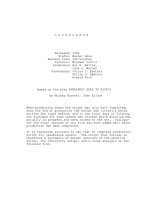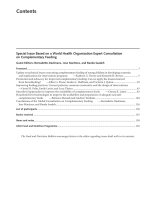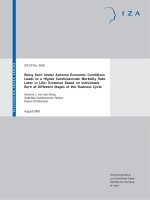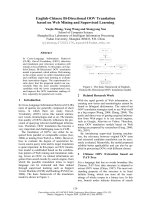- Trang chủ >>
- Đề thi >>
- Đề thi lớp 4
English linguistics
Bạn đang xem bản rút gọn của tài liệu. Xem và tải ngay bản đầy đủ của tài liệu tại đây (319.36 KB, 61 trang )
<span class='text_page_counter'>(1)</span><div class='page_container' data-page=1>
<b>ENGLISH LINGUISTICS</b>
</div>
<span class='text_page_counter'>(2)</span><div class='page_container' data-page=2>
PHONETICS AND PHONOLOGY
<b>1.Phonetics and Phonology</b>
<i><b>a.What is phonetics?</b></i>
*
<b>Phonetics</b>
and articulators/organs of speech
*Articulatory Phonetics:
*Auditory Phonetics:
*Acoustic Phonetics
*
<b>3 aspects</b>
of the study of phones/sounds:
-
<b>physical</b>
: articulation, height, length, quality, loudness, pitch,
melody
-
<b>accent</b>
: regional characteristics
</div>
<span class='text_page_counter'>(3)</span><div class='page_container' data-page=3>
Phoneme - Phone - Allophone
1.Speech sounds are the movements of the air through human
articulators (organs of speech). The air moves through
* the nasal cavity (the nose), nasal sounds /m, n,
…
/ appear;
* the oral cavity (the mouth), oral sounds /p, b, f, v, t, d,
…
/ appear;
* the two lips, bi-labial sounds /p, b, m,
…
/ appear
…
</div>
<span class='text_page_counter'>(4)</span><div class='page_container' data-page=4>
* A phoneme is a more abstract unit. It is defined as the smallest unit of
language existing as such a speech - sound which is capable of
distinguishing one word from another or one grammatical form of a word
from another form of the same word.
* An allophone can be defined as a predictable phonetic variant of a
phoneme. An actually pronounced speech sound is always a variant
( allophone) of a phoneme. Different allophones of one and the same
phonemes are speech sounds which have one or more articulatory features
and, therefore, acoustic features in common and at the same time differ
from each other in some (usually slight) degree because of the influence of
their position, of the neighboring speech sounds and of other purely
</div>
<span class='text_page_counter'>(5)</span><div class='page_container' data-page=5>
* An allophone is a variant of a phoneme. The allophones of a
phoneme form a set of sounds that
(a) do not change the meaning of a word,
(b) are all very similar to one another, and
(c) occur in phonetic contexts different from one another and
(d) have non -distinctive differences.
* In other words,
+ Phoneme
is the minimal meaningless unit of language. It containsa bundle of phonetic distinctive features,
</div>
<span class='text_page_counter'>(6)</span><div class='page_container' data-page=6>
<i><b>b.The classification of phonemes</b></i>
:
*
<b>Segmental</b>
phonemes (consonants, vowels) based on
-phonetically distinctive features, articulation, height,
length, quality
*
<b>Suprasegmental </b>
phonemes (stress, intonation) based on
-loudness (height, length, voice quality),
</div>
<span class='text_page_counter'>(7)</span><div class='page_container' data-page=7>
<i><b>c.The classification of Consonants</b></i>
based on
*
<b>Points of articulation</b>
/Articulators/Organs of speech
*
<b>Manner of articulation</b>
*
<b>Voice</b>
*
<b>Aspiration</b>
<i><b>d.The classification of Vowels</b></i>
based on
</div>
<span class='text_page_counter'>(8)</span><div class='page_container' data-page=8></div>
<span class='text_page_counter'>(9)</span><div class='page_container' data-page=9></div>
<span class='text_page_counter'>(10)</span><div class='page_container' data-page=10>
<sub>DIPHTHONG</sub>
<sub>A diphthong is a combination of two vowels pronounced within one syllable. </sub>
<sub>The first element of a diphthong is called the nucleus, the second element is </sub>
called the glide. The nucleus is a strong, clear and distinct vowel sound.
The glide is weak in the articulation of a diphthong. The organs of speech
start from the position necessary for the first vowels and glide in the
direction of the second vowels . The first element in all the diphthongs is
stressed and is stronger than the second.
</div>
<span class='text_page_counter'>(11)</span><div class='page_container' data-page=11>
Diphthongs can be classified into
a- retracting ( ending in /u /, e.g. now, town, go, show),
b- fronting (ending in / i /, e.g. eye, why, say, day, boy,
destroy), and
c- centering (ending in / /, e.g.
∂
hear, near).
Diphthongs can also be classified into
a- closing ( ending in either / i / or / u /, e.g. life, like, say,
waiter, phone, know ) or
</div>
<span class='text_page_counter'>(12)</span><div class='page_container' data-page=12>
<i><b>e.Syllables</b></i> based on
*the structure: <b>ONSET + RHYME (NUCLEUS + CODA)</b>
*the ending +with vowel: <b>OPEN SYLLABLE</b>
+with consonant: <b>CLOSED SYLLABLE</b>
*stressed or unstressed syllables
<i><b>f.Stress</b></i> placed
*over + the root
*over + prefix
*over or before + suffix
*over + compounds
<i><b>g.Intonation types</b></i> classified into
*<b>fall</b> (affirmation, confirming information in WH-question)
*<b>rise</b> (YES-NO question)
<b>*rise-fall</b> (listing, correcting wrong facts...)
<b>*fall-rise</b> (politeness, uncertainty, tail-questions)
</div>
<span class='text_page_counter'>(13)</span><div class='page_container' data-page=13>
PHONOLOGICAL CHANGES
<b>1.Assimilation: </b>
Two adjacent consonants within a word or at word boundaries
often influence each other in such a way that the articulation of one sound
becomes similar to or even identical with the articulation of the other one.
<b>2.Degrees of Assimilation</b>
:
<b>2.1.Complete Assimilation</b>
: For example,
<i>horse shoe</i>
/ho:s
u:/ --->/'ho:
u:/.
<b>2.2.Partial Assimilation</b>
: For example, in the assimilation of the alveolar variants
of the consonants /t/, /d/, /n/, /l/, /s/,/z/ to the dental consonant /
/ and/
/ the
main phonemic features of the former are retained, but the point of articulation
is changed, and they are replaced by the dental variants of the same phonemes
under the influence of the following /
/ and/
/ . Another example is the
assimilation of the sound /v/ in fivepence /faiv p
ns/---> /faifp
ns/.
<b>2.3.Intermediate Assimilation: </b>
Examples of intermediate assimilation are
<i>gooseberry </i>
/'guzb
ri/, where / s/ in
<i>goose </i>
/gu:s/ is replaced by /z/ under the
</div>
<span class='text_page_counter'>(14)</span><div class='page_container' data-page=14>
<b>2.Accommodation</b>
In accommodation the accommodated sound does not change its main
phonemic features and is pronounced as a variant of the same
phoneme slightly modified under the influence of a neighbouring
sound. In modern English there are six main types of
accommodation:
<b>2.1. Rounding</b>
: An unrounded variant of a consonant phoneme is
replaced by its rounded variant under the influence of a following
rounded vowel phoneme, as at the beginning of the following words
:
<b> Unrounded variants of Rounded variants of</b>
<b> consonant </b>
<b>consonant </b>
/ti:/
<i>tea</i>
/tu:/
<i>too</i>
</div>
<span class='text_page_counter'>(15)</span><div class='page_container' data-page=15>
2.2.
<b>Nasalization</b>
: a vowel becomes nasalized when it
stands before, after or between nasal consonants. For
example:
<i>at, attack ---> an, mad, man</i>
2.3.
<b>Aspiration</b>
: a consonant /p, t, k/ becomes aspirated
when it stands before a vowel except rounded
vowels.For example: hat, stop, sky ---> time, people, can
2.4.
<b>Syllabication</b>
: some clusters of consonants become
syllabic when they are prounced as a syllable with a
</div>
<span class='text_page_counter'>(16)</span><div class='page_container' data-page=16>
<b>3.Elision</b>
The nature of elision may be stated quite simply : under certain
circumstances sounds disappear : one might express this in more
technical language by saying that in certain circumstances a phoneme
may be realized as zero, or have zero realization. As with assimilation,
elision is typical of rapid, casual speech. We will look at some
examples of elision:
<b>3.1.Loss of weak vowel</b>
after p,t, k. In words like
<i>potato, tomato, canary</i>
,
<i>perhaps, today</i>
, the vowel in the first syllable may disappear; the
aspiration of the initial plosive takes up the whole of the middle portion
of the syllable, resulting in these pronunciations : /p'teitou/, /t'ma:tou/
<b>3.2.Avoidance of complex consonant</b>
clusters. E.g.
<i>acts</i>
---> /æks/,
<i>looked</i>
back /luk bæk/
<b>3.3.Loss of final</b>
v in "of" before consonants. E.g.
<i>lots of them</i>
/lot
ð
m/
</div>
<span class='text_page_counter'>(17)</span><div class='page_container' data-page=17>
<b>4.Weakening</b>
:
In English speech, there are certain words which have two forms
of pronunciation:
a- strong, or full, form and
b- weak, or reduced form.
As an example, the word
<i>can</i>
can be pronounced as /kæn/ (strong
</div>
<span class='text_page_counter'>(18)</span><div class='page_container' data-page=18>
<b>There are three degrees of the reduction of strong forms:</b>
<b>1.The reduction of the length of a vowel without changing its quality</b>
<b> Strong form Weak forms with qualitative reduction</b>
You [ju:] [ju] [ju]
He [hi: ] [hi] [hi]
Your [jo:] [jo] [jo]
<b>2.The second degree of reduction consists in changing the quality of a vowel</b>
<b> Strong forms Weak forms with qualitative reduction</b>
<b> </b>For [fo:] [f∂]
Her [h∂ ] [h∂]
<b>3.The third degree involves the omission of a vowel or consonant.</b>
<b> Strong form Weak forms</b>
Am [æm] [m]
Of [ov] [v]
</div>
<span class='text_page_counter'>(19)</span><div class='page_container' data-page=19>
<b>5.Linking and Insertion of /r/</b>
In natural communication, we sometimes link words together.
5.1.The normal linking is:
Ex.: What time is it? (It’s half past twelve.)
5.2.The most familiar case is the use of
<b>linking r.</b>
Examples are:
a-
<i>here</i>
/ hi∂ / but
<i>here are </i>
/ hi∂r∂ /
four /fo: /
<i>for egg</i>
/ fo: regz /
b- formula A / fo:mi∂l∂r ei /
c- media event / mi: di∂r ivent /
</div>
<span class='text_page_counter'>(20)</span><div class='page_container' data-page=20>
GRAMMAR: MORPHOLOGY
<b>1.1.WORD-STRUCTURE</b>
<i><b>a.What is morphology</b></i>?
*Rules of word-structure: rules of forming words from morphemes
<i><b>b.What is a morpheme</b></i>?
*A minimal/smallest meaningful unit of language
*An elemental minimal meaningful unit of forming word-structure
<b>*MORPHEME and ALLOMORPHS/ MORPHS</b>
<i><b>c.Types of morphemes</b></i> identified on the basis of
<b>*FREE-BOUND: IDENTIFIED = IDENTITY + FY (derivational) + ED (inflectional)</b>
<b>*ROOT-AFFIXES (PREFIXES, INFIXES, SUFFIXES) – STEM/BASE</b>
<b>*DERIVATIONAL – INFLECTIONAL</b>
<i><b>d.Rules of word-formation</b></i>
<b>*Types of Word based on types of morphemes: </b>
</div>
<span class='text_page_counter'>(21)</span><div class='page_container' data-page=21>
<b>1.2.WORD-FORMATION</b>
<i><b>1. AFFIXATION</b></i><b> : adding affixes to the old roots/ words</b>
<b>Ex.: GANGSTER, LONDONER, NON-SMOKING</b>
<i><b>2. COMPOUNDING</b></i><b> : joining the old roots/ words</b>
<b>Ex.: EASY-GOING, MISSING-IN-ACTION</b>
<i><b>3. CONVERSION</b></i><b> : changing the word classes of the old words</b>
<b>Ex.: KNIFE (n) ---> KNIFE (v), </b>
<b>MOTHER (n)---->MOTHER (v)</b>
<i><b>4. BACK-FORMATION</b></i><b> : shortening the ending of the old words</b>
<b>Ex.: BURGLE (v) <---BURGLAR, </b>
</div>
<span class='text_page_counter'>(22)</span><div class='page_container' data-page=22>
<i><b>5. ABBREVIATION / CLIPPING</b></i>
<b> : shortening the initial, middle, or / </b>
<b>and final parts of the old words</b>
<b>Ex.: (IN)FLU(ENZA), (TELE)PHONE, EXAM(INATION)</b>
<i><b>6. ACRONYMY / INITIALISM</b></i>
<b> : shortening the final parts of each word </b>
<b>in the old phrases and joining their initial parts into one new word</b>
<b>Ex.: A(TOMIC)-BOMB, UN, UNESCO,...</b>
<i><b>7. BLENDING</b></i>
<b> : shortening the final part of the first word and the </b>
<b>initial part of the second word and blending them into one new </b>
<b>word having the new concept</b>
</div>
<span class='text_page_counter'>(23)</span><div class='page_container' data-page=23>
<i><b>8. REDUPLICATION</b></i><b> : doubling the old words by repeating the same </b>
<b>rhyme of the old words </b>
<b>Ex.: TALKIE-WALKIE, TICK-TOCK, </b>
<i><b>9. BORROWING</b></i><b> : borrowing the foreign words and changing the </b>
<b>sounds by assimilation</b>
<b>Ex.: SOVIET, SPUTNIK,...</b>
<b>10.INTERNATIONAL TRANSLATION:</b>
<b>Ex.: 3-READINESS MOVEMENT; </b>
<b>3-NO CAMPAIGN- 3-YES CAMPAIGN; </b>
<b>RED AND EXPERT; </b>
</div>
<span class='text_page_counter'>(24)</span><div class='page_container' data-page=24>
GRAMMAR: SYNTAX
<b>1.WORD-CLASS (PARTS OF SPEECH)</b>
<b>*Criteria</b>
to classify words into word classes: N, V, ADJ, ADV,
ART, PRO, NUM, AUX, PREP, CONJ, RELATOR, NEGATOR,
INTENSIFIER, ...
+word order/position
+grammatical function
+form/word stress
+meaning
+development:
-OPEN CLASSES: N, V, ADJ, ADV
-CLOSED CLASSES: PRO, ART, AUX, MODAL, NUM,
</div>
<span class='text_page_counter'>(25)</span><div class='page_container' data-page=25>
<b>2.PHRASES:</b>
<b>2.1.Syntactic relations</b>
in
<b>Phrases: MODIFICATION, </b>
<b>COMPLEMENTATION, COORDINATION</b>
2.2.PHRASES can be classified on the basis of
+sentence structure: NP, VP
+word classes of the head/centre: NP, VP, ADJP, ADVP, PREPP
+ -ENDOCENTRIC P./HEADED-P.
-EXOCENTRIC P./NON-HEADED-P.
+meaning:
-FREE P.
</div>
<span class='text_page_counter'>(26)</span><div class='page_container' data-page=26>
<b>3.CLAUSES/SENTENCES:</b>
<b>3.1.Syntactic relations</b>
in
<b>Clauses/SENTENCES</b>
: PREDICATION
3.2.Characteristics of SENTENCES (PREDICATION):
3.2.1.proposition:
1.S+V/2.NP+VP
2.ideational meaning: complete thought
3.2.2.modality: 1.Verb moods
2.Modal verbs, Modal words
3.Intonation, Punctuation marks
3.2.3.communicativity= 1.Topic-Comment
2.Theme-Rheme
</div>
<span class='text_page_counter'>(27)</span><div class='page_container' data-page=27>
<b>3.3.Clauses</b>
classified on the basis of
+VERB Clauses:
1.Finite clauses
2.Non-Finite Clauses
3.VERBLESS Clauses
+grammatical functions:
1.-INDEPENDENT – DEPENDENT Clauses
</div>
<span class='text_page_counter'>(28)</span><div class='page_container' data-page=28></div>
<span class='text_page_counter'>(29)</span><div class='page_container' data-page=29>
<b>4.Sentence elements:</b>
<b>4.1.in Sentences: </b>
<b>-Subject (S): </b>
<b>- Helen came here.</b>
<b>-Verb (V):</b>
<b>- Helen came here. </b>
<b>-Direct/Indirect Object (DO/IO): - Helen gave sweets to Jim. </b>
<b>-Complement (C): - Helen was director of the company. </b>
<b>-Adverbial (A):</b>
<b>- Helen came here.</b>
<b>4.2.in Phrases: </b>
<b>-Modifier (M): </b>
<b>- English pronunciation is very difficult.</b>
</div>
<span class='text_page_counter'>(30)</span><div class='page_container' data-page=30>
<b>5.Basic structures/ Obligatory structures</b>
:
5.1.S+V:
Birds fly in the sky.
(NP+VP)
5.2.S+V+A:
Helen lived here.
(NP+V+ADV)
She stayed in this city.
(NP+V+PP)
5.3.S+V+C:
They were students here.(NP+V+NP)
They were intelligent.
(NP+V+ADJ)
5.4.S+V+DO:
Helen loved Jim much. (NP+V+NP)
5.5.S+V+IO+DO:Helen gave him sweets. (NP+V+NP+NP)
S+V+DO+IO:Helen gave sweets toJim.(NP+V+NP+TO+NP)
5.6.S+V+O+A: They put many books on the table.
(NP+V+NP+PP)
They put many books here.(NP+V+NP+ADV)
</div>
<span class='text_page_counter'>(31)</span><div class='page_container' data-page=31>
<b>6.TYPES OF SENTENCES</b>
<b>6.1.Grammatical structures:</b>
<b>6.1.1.Simple – Compound – Complex sentences</b>
<b>6.1.2.Kernel – Transformational sentences:</b>
</div>
<span class='text_page_counter'>(32)</span><div class='page_container' data-page=32>
<b>6.2.Functional structures</b>
<b>:</b>
<b>6.2.1.Message structure: TOPIC + COMMENT</b>
<b>6.2.2.Information structure: OLD/GIVEN + NEW</b>
<b>6.2.3.Transitivity structure:</b>
<b>+IDENTIFICATIONAL sentences</b>
<b>+QUALITATIVE sentences</b>
</div>
<span class='text_page_counter'>(33)</span><div class='page_container' data-page=33>
<b>6.2.4.Communicative structure:</b>
<b>+Statement</b>
<b>+Declaration/Affirmative</b>
<b>+Question/Interrogative</b>
<b>+Negative</b>
<b>+Order/Imperative</b>
<b>+Command</b>
<b>+Request</b>
<b>+Greeting</b>
<b>+Exclamation</b>
</div>
<span class='text_page_counter'>(34)</span><div class='page_container' data-page=34>
7.
<b>Sentence analysis: </b>
</div>
<span class='text_page_counter'>(35)</span><div class='page_container' data-page=35>
<b>*Branching-Tree Diagrams for Sentence Analysis</b>
<b> S</b>
<b> S1 S2</b>
<b> NP VP </b> <b> N(P) V(P)</b>
<b> </b> <b> VP</b> <b> NP </b> <b> </b> <b> </b>
<b>Dem N Aux MV Quant Adj N Conj. N/Pro V</b>
<i><b> </b></i>
</div>
<span class='text_page_counter'>(36)</span><div class='page_container' data-page=36>
<b>SEMANTICS</b>
<b> a.*Semantics</b>: the study of sense, proposition (meaning in language)
*<b>Pragmatics</b>: the study of the relationships among sense, proposition, referent
and the speaker’s/ writer’s intentions (meaning in use/ communication)
<b>b.*Words with sense but without referent</b>
*<b>Words/Sentences with the same referents but with different </b>
<b>senses/propositions</b>
<b>c.*Sense of words/expressions </b>(the place of a word/an expression in a
system of semantic relationships with other words/expressions in the language;
an indispensable hard core of meaning)
*<b>Proposition of sentences </b>(part of the meaning of the utterance of a
declarative sentence which describes some state of affairs)
</div>
<span class='text_page_counter'>(37)</span><div class='page_container' data-page=37>
<b>d.Sense relations in words and sentences</b>: relations of the senses of predicates/
lexemes/word-forms or the propositions of sentences
<b>*Homonymy</b>: predicates with same sounds or/and spellings but unrelated senses.
<b>Ex: </b><i>(the) barks (of the tree) – (The dog) barks; aunt – aren’t – ain’t [ant];(the) wind – </i>
<i>(to) wind.</i>
<b>*Polysemy</b>: predicates with related senses by means of metaphor, metonymy. Ex:
<i>He is a HEAD of the company; he has a hard HEAD but no intelligent HEAD.</i>
*<b>Synonymy</b>: predicates denoting the same referent/concept with same senses
(semantic, connotative, situational/stylistic, regional synonyms)
Ex: <i>begin – start – commence – depart; country – motherland – fatherland; parent – </i>
<i>mother/father – dad/mum; fall - autumn</i>
*<b>Antonymy</b>: predicates denoting the same referent/concept with contradictory,
complementary, gradably opposite, relationaly/reversively opposite, or incompatible
senses. Ex: <i>alive – dead; long – short; give – receive, older – younger; spring – </i>
<i>summer – autumn - winter</i>
</div>
<span class='text_page_counter'>(38)</span><div class='page_container' data-page=38>
<b>*Meronymy</b>
: predicates with senses denoting the
whole and predicates with senses denoting its parts.
Ex:
<i>tree trunk, root, branch, ; human (body) </i>
<i>head, body, hands, legs…)</i>
<b>*Lexical/Semantic Fields (Collocations):</b>
</div>
<span class='text_page_counter'>(39)</span><div class='page_container' data-page=39>
e.SEMANTIC CHANGE
<b>1-</b><i><b> Semantic broadening</b></i>
Semantic broadening is the process in which the meaning of a word becomes
more general or more inclusive than its historical earlier form. Examples:
Bird : <i>small fowl </i> <i>-> any avian</i>
Barn : <i>place to store barley</i> <i>-> any agricultural building</i>
Aunt : <i>father's sister -> father's or mother's sister</i>
<i><b>2.Semantic narrowing</b></i>
Semantic narrowing is the process in which the meaning of a word becomes
less general or less inclusive than its historically earlier meaning. Examples:
Meat<i> :</i> <i>any type of food ->flesh of an animal</i>
Fowl<i> : </i> <i>any bird ->a domestic bird</i>
</div>
<span class='text_page_counter'>(40)</span><div class='page_container' data-page=40>
<i><b>3.Amelioration</b></i>
In amelioration the meaning of a word becomes more positive or
more favourable.
Examples:
Pretty
<i>: tricky, sly, cunning </i>
<i>->attractive</i>
Knight
<i>:</i>
<i>boy</i>
->
<i>a man of honorable military rank</i>
<i><b>4.Pejoration</b></i>
In pejoration, the meaning of a word becomes more negative or
unfavourable. Examples:
</div>
<span class='text_page_counter'>(41)</span><div class='page_container' data-page=41>
<i><b>4.Semantic weakening</b></i>
In this process of language change, the meaning of the word
becomes weakened.
Examples:
Wreak
<i>: avenge, punish </i>
<i>->to cause, to inflict</i>
Quell
<i>: kill, murder</i>
->
<i>to put down, to pacify</i>
<b>5.</b>
<i><b>Semantic shift</b></i>
Semantic shift is a process in which a word loses its former
</div>
<span class='text_page_counter'>(42)</span><div class='page_container' data-page=42>
<b>*</b>
<i><b>Metaphor</b></i>
Metaphor is a figure of speech based on a perceived similarity
between distinctive objects or actions. Metaphorical change usually
involves a word with a concrete meaning taking on a more abstract
sense, although the word's original meaning is not lost. The
meanings of many English words have been extended through
metaphor.
Metaphor may be based on similarity of
a- shape (e.g.
<i>head of a cabbage</i>
),
b- position (e.g.
<i>the tail of procession</i>
),
c- movement (e.g.
<i>the caterpillar of a tank</i>
),
d- function (e.g.
<i>the finger of the instrument</i>
),
e- colour (e.g.
<i>orange</i>
), and
</div>
<span class='text_page_counter'>(43)</span><div class='page_container' data-page=43>
<b>*</b>
<i><b>Metonymy</b></i>
Metonymy can be considered as the semantic shift on the basis
of the real relation between different objects.
This kind of meaning transfer can be based on
a-the use of the name of the container for the thing contained
(e.g.
<i>the auditorium</i>
for the audience),
b-the name of a material for the thing made from the material
(e.g.
<i>the marble, the iron</i>
..),
</div>
<span class='text_page_counter'>(44)</span><div class='page_container' data-page=44>
<b>f.Sense properties of the sentence</b>
<b>*Analytic sentence</b>
: necessarily TRUE, as a result
of the senses of the words in it.
<b>Ex: </b>
<i>- Vietnam is </i>
<i>located in Asia. – 2 and 2 is 4.</i>
<b>*Synthetic sentence</b>
: NOT analytic, but may be
either true or false, depending on the way the world
is.
<b>Ex: </b>
<i>- The teacher is from Hue. - She is happy.</i>
</div>
<span class='text_page_counter'>(45)</span><div class='page_container' data-page=45>
<b>g. Semantic and pragmatic relations among utterances</b>
<b>*Paraphrase: </b>Ex: <i>- He is an orphan. He has no father nor mother.</i>
*<b>Presupposition: </b>Ex: <i>- Her son sold his old car. She was married. She had a son. </i>
<i>Her son bought a car long time ago. </i>
<b>*Entailment:</b> - Ex: <i>- Her son sold his old car. Someone did something to something. </i>
<i>Someone sold something. Something happened to the car. </i>
*<b>Speech acts</b>:
<b> *Utterances</b> traditionally classified into
+<b>Constative Utterance</b>: describes/ asserts some state of affairs and
is NOT performative: Ex: <i>-The weather is fine. –She is beautiful.</i>
+<b>Performative Utterance</b>: actually describes the act that it performs,
</div>
<span class='text_page_counter'>(46)</span><div class='page_container' data-page=46>
*<b>3 acts/meanings</b> an utterance performs:
+<b>LOCUTIONARY ACT (LOCUTION)</b> = proposition
Ex: <i>- There are some pieces of fish on the table. =</i>
<i>There existed something on the defined table.</i>
+<b>ILLOCUTIONARY ACT (ILLOCUTION</b>) is the act viewed in terms of the
utterance’s significance within a conventional system of social interactions.
Illocutions are acts defined by social conventions.
Ex: <i>- There are some pieces of fish on the table. =</i>
<i>The diner complains that the table is not clean. </i>
+<b>PERLOCUTIONARY ACT (PERLOCUTION</b>) carried out by a speaker making
an utterance is the act of causing a certain effect on the hearer and others.
Ex: <i>- There are some pieces of fish on the table. =</i>
The diner suggests the waiter should clean the table,
</div>
<span class='text_page_counter'>(47)</span><div class='page_container' data-page=47>
<b>*PERFORMATIVE FORMULA:</b>
<b>I + (HEREBY) + PERFORMATIVE VERB + NP + to VP/ THAT-clause</b>
<b>We</b> <b> (affirmative, simple present tense, indicative mood, active voice)</b>
<b>They</b> <b> + (passive voice)</b>
<b>He/She/It </b>
<b>*A PERFORMATIVE VERB</b> is one which, when used in a simple positive present tense sentence,
with 1st person singular subject, can make the utterance of that sentence performative.Ex:
<i>invite, greet, ask, inform</i>,…
<b>*Explicit performative utterances</b> containing performative hypothesis/ formula.
Ex: <i>- I agree with your ideas. – I recommend that we should book rooms at that hotel. – I </i>
<i>apologize that I dis wrong things to you.</i>
*<b>Implicit performative utterances</b> implicitly explained by performative formula.
Ex: <i>- Go out! (I order you to go out). </i>
<i>- Have a beer please! (I invite you to have a beer). </i>
<i>- All passengers are requested to go through this check point. (We request the passengers to </i>
<i>go through this check point.).</i>
</div>
<span class='text_page_counter'>(48)</span><div class='page_container' data-page=48>
<b>*Speech acts</b> represented through <b>sentence types </b>creating Direct and Indirect Illocutions:
<b>-Declarative: </b>Ex: -<i>I suggest that we should go home earlier.</i>
<b>-Interrogative: </b>Ex: <i>-How are you? (I ask you about your health)</i>
<b>-Imperative: </b>Ex<i>: -Excuse me!</i>
*<b>Speech acts</b> classified into 5 types:
<b>1.Commissive : </b>a speech act that commits the speaker to doing something in the
future, such as <i>a promise or a threat,</i><b> Ex: -</b><i>I 'll take you to the movies tomorrow.</i>
<b>2.Declarative : </b>a speech act which changes the state of affairs in the world. For
example, during the wedding ceremony the act of marriage is performed when the
utterance <i>I now pronounce you man and wife</i> is uttered.
<b>3.Directive : </b>a speech act that has the function of getting the listener to do something,
such as <i>a suggestion, a request, or a command</i><b>.</b>
<b>4.Expressive : </b>a speech act in which the speaker expresses feelings and attitudes
about something, such as <i>an apology, a complaint, to thank someone, to congratulate </i>
<i>someone.</i>
</div>
<span class='text_page_counter'>(49)</span><div class='page_container' data-page=49>
<b>*Inference</b>: any conclusion that one is reasonably entitled to draw from a sentence or
utterance. Inferences are represented through entailments and conversational
implicatures.
<b>*Implicature/Implication</b>: another kind of inference, distinct from entailment. Implicature
is a matter of utterance meaning, and not of sentence meaning. Implicature is not a form
of inference that can be predicted solely from a knowledge of the system of sense
relations between sentences.
---> Grice distinguished 2 different sorts of implicature:
* <b>conventional implicature</b> and
* <b>conversational implicature</b>.
They have in common the property that they both convey <b>an additional level of </b>
<b>meaning</b>, beyond the semantic meaning of the words uttered.
</div>
<span class='text_page_counter'>(50)</span><div class='page_container' data-page=50>
<b>*Implicature</b> is based on maxims of (1) quantity/informativeness; (2)
quality/truthfulness; (3) relation/relevance, (4) manner/clarity,...in conversational
co-operativeness/ cooperative principle)
1.Quantity: : Make your contribution as informative as is required (for the
current purpose of the exchange)
: Do not make your contribution more informative than
required.
2.Quality : Do not say what you believe to be false
: Do not say that for which you lack adequate evidence
3.Relation : Be relevant
4.Manner : Avoid obscurity of expression
<b>*Conventional implicatures</b> are associated with specific words and result in additional
conveyed meanings when those words are used: <b>BUT, EVEN, YET, AND, </b>
</div>
<span class='text_page_counter'>(51)</span><div class='page_container' data-page=51>
<b>BUT: </b>The interpretation of any utterance of the type<b> “p but q” </b>will be based on the
conjunction<b> p & q </b>plus an implicature of “<b>contrast</b>” between the information in <b>p</b>
and the information in <b>q.</b>
<i>Ex: -Mary suggested black, <b>but</b> I chose white.</i>
<b>EVEN: </b>when <b>EVEN</b> is included in any sentence describing an event, there is an
implicature of “<b>contrary to expectation</b>”
<i>Ex: -<b>Even</b> John came to the party.</i>
<b>YET: </b>the implicature of <b>YET</b> is that the present situation is expected to be different, or
perhaps the opposite, at a later time.
<i>Ex: -<b>Denis </b>isn’t here<b> yet</b>.</i>
<b>AND: </b>the implicature of <b>AND</b> is “<b>in addition, plus</b>”.
<i>Ex: -Yesterday, Mary was happy <b>and</b> ready to work.</i>
<b>AND: </b>the implicature of <b>AND</b> is “<b>and then</b>”.
</div>
<span class='text_page_counter'>(52)</span><div class='page_container' data-page=52>
<b>*Conversational implicatures </b>arise only in a particular context of utterance<b>.</b>
<b>(1a) Generalized conversational implicatures: </b>no special background knowledge is
required in the context to calculate the additional conveyed meaning.
<i>Ex: </i>
<i>1.Charles: I hope you brought the bread and the cheese.</i>
<i> Dexter: Ah, I brought the bread.</i>
<i>----> <b>Charles must intend that Dexter infer that what is not mentioned was </b></i>
<i><b>not brought</b>.</i>
<i>----><b>The maxim of quantity</b></i>
<i>2.Doobie: Did you invite Bella and Carthy?</i>
<i> Mary: I invited Bella.</i>
<i>----> <b>The maxim of quantity</b></i>
</div>
<span class='text_page_counter'>(53)</span><div class='page_container' data-page=53>
<b>(1b) Scalar (Generalized conversational) implicatures: </b>are commonly
communicated on the basis of a scale of values by using words expressing
quantity from the highest to the lowest value:
<b><all, most, many, some, few></b>
<b><always, often, sometimes></b>
or the scale of “<i><b>likelihood</b></i>” <<b>certain, possible</b>>; the scale of “<i><b>obligation</b></i>’’
<<b>must, should</b>>; the scale of “c<i><b>oldness</b></i>’ <<b>cool, frozen</b>>...
The basis of scalar implicature is that, when any form in a scale is asserted,
<i><b>the negative of all forms higher on the scale is implicated</b></i>.
<i>Ex:1: I’m studying linguistics and I’ve completed some of the required courses.</i>
<b>---> </b><i><b>some +> not all</b></i>
---> <i><b>the maxim of quantity (most informative) </b>and <b>of quality (truthful)</b></i>
<i>2.It’s possible that they were delayed.</i>
<i>---> <b>possible +>not certain</b></i>
</div>
<span class='text_page_counter'>(54)</span><div class='page_container' data-page=54>
<b>(2) Particularized conversational implicatures (typically Implicatures): our conversations take</b>
place in very specific contexts in which locally recognized inferences are assumed. Such
inferences are required to work out the conveyed meanings which result from particularized
conversational implicatures.
<i>Ex:1.Rick: Hey, coming to the wild party tonight?</i>
<i> Tom: My parents are visiting.</i>
---> <i>+>Tom won’t come to the party</i>.
---> <i>the maxim of relation (relevant</i>)
2.A: “<i>What subjects is Jack taking</i>?”
B: “<i>He’s not taking Linguistics</i>”
---> +> <i>B does not know exactly which subjects Jack is taking</i>.
---> <i>the maxim of quantity (informativeness</i>)
3.A: “<i>Who was that man you were talking to?”</i>
B: “<i>That was my mother’s husband”</i>
---> +> <i>B’s mother’s husband is not B’s father</i>.
---> <i>the maxim of manner (clarity, brevity</i>)
<i>4.A: “Was there a fiddler at the bar last night?”</i>
<i> B: “As far as I know, there was a man scraping a bow across a violin”</i>
----> +><i>The fiddler at the bar was not very good.</i>
</div>
<span class='text_page_counter'>(55)</span><div class='page_container' data-page=55></div>
<span class='text_page_counter'>(56)</span><div class='page_container' data-page=56></div>
<span class='text_page_counter'>(57)</span><div class='page_container' data-page=57></div>
<span class='text_page_counter'>(58)</span><div class='page_container' data-page=58></div>
<span class='text_page_counter'>(59)</span><div class='page_container' data-page=59></div>
<span class='text_page_counter'>(60)</span><div class='page_container' data-page=60></div>
<span class='text_page_counter'>(61)</span><div class='page_container' data-page=61></div>
<!--links-->









